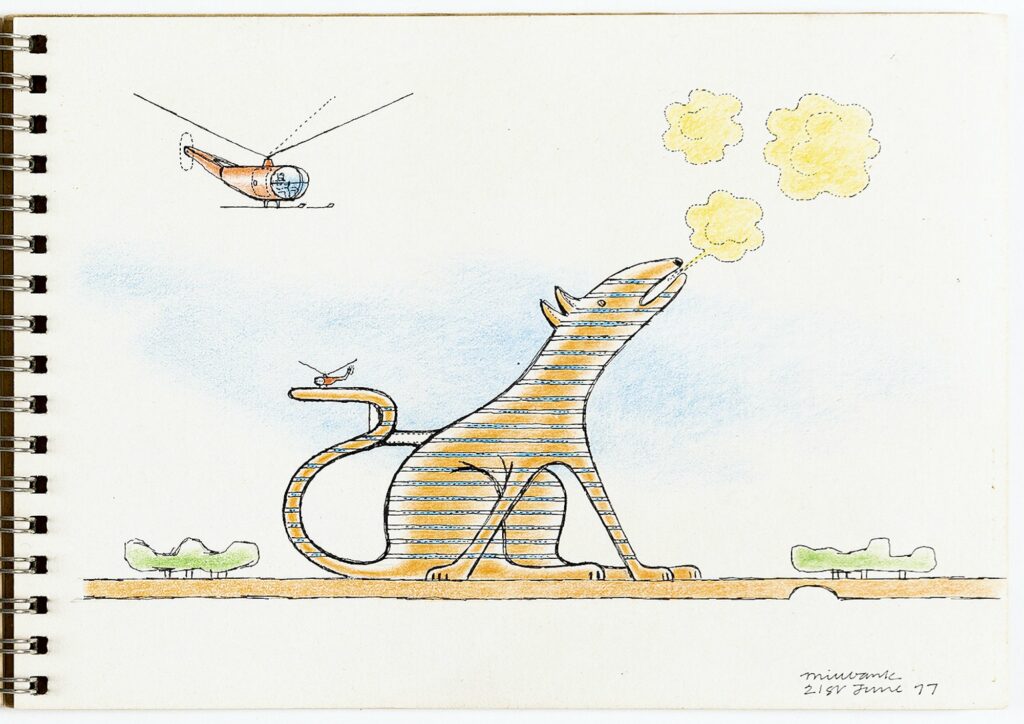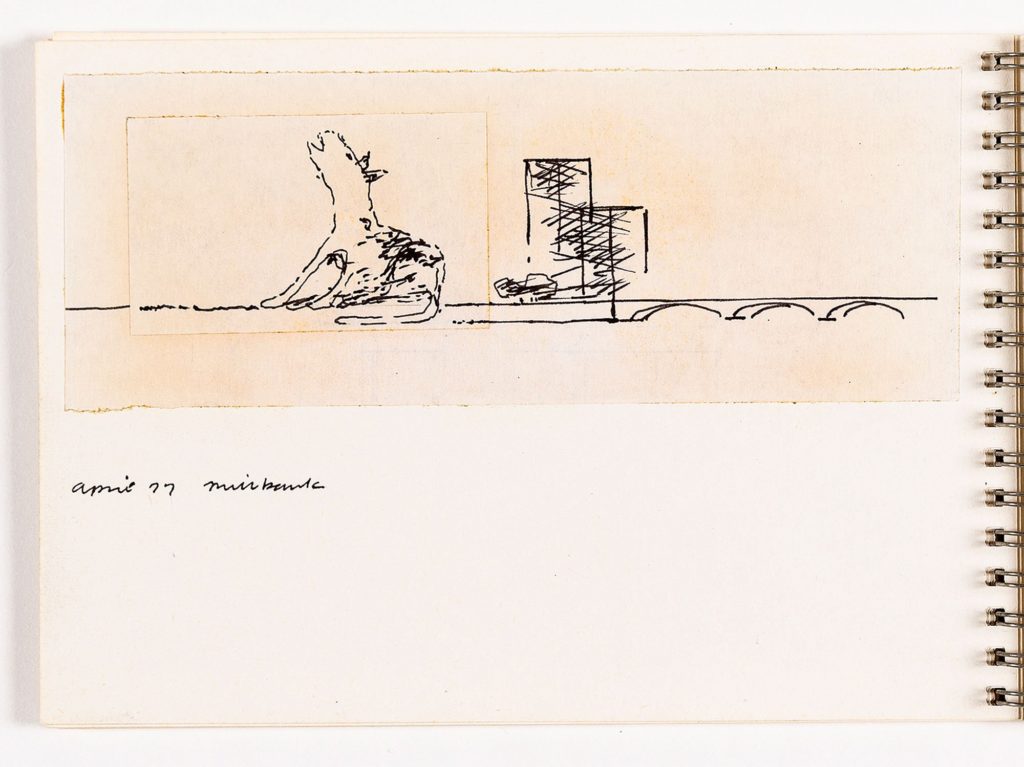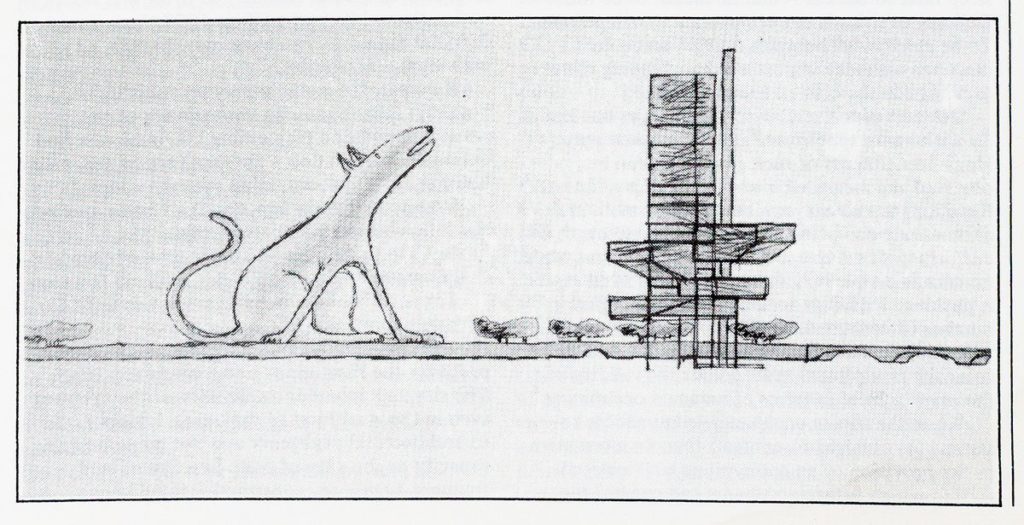Animals
– James Gowan and Ellis Woodman

Ellis Woodman: Your sketchbooks from the early 70s include a series of proposals for gigantic animal-shaped buildings on sites across London. There is a later scheme, drawn up in response to the Milbank Housing Competition of 1977, which takes the form of a vast howling dog. What was the impulse behind these drawings?
James Gowan: The quality I had in mind was the one that HG Wells describes in The War of the Worlds. An object arrives in the middle of an English village and it is pretty fearsome. Certainly it is not architectural in the sense of eloquently telling you what it is. You can’t see a door. It just lies there smouldering and you are left guessing what it is until the hatch opens a couple of days later. It was that sense of wonder I was aiming for.
EW: The drawings have something in common with the collages that Hans Hollein was producing in the 60s or, take an example from closer to home, with a project like Archigram’s Plug in City. The common strategy is the insertion of an extraordinary object into an existing setting. In each case the work isn’t proposed as an alternative to the historic city but as a surreal counterpoint.
JG: In a way you are right. It had become clear that the procedures that started in the 50s weren’t working. The implication of what Hollein and Archigram were doing and the implication of many of my sketches was that you kept and adapted the best of what was around. The difference is that their things are hellishly artistic and the HG Wells idea isn’t. It is pretty nasty. None of us want a red hot flying saucer in our backyard. It is not going to help the human predicament too much.
EW: So you think of your animals in the same way? They are not friendly visitors?
JG: No, they are critical of the situation. There was a malicious intent that passed people by. You could think of them as a monument to the three day week.
EW: They are witnesses to a moral decline?
JG: I think they must be. The evil dog is not wagging its tail. It is pretty upset about most things. That period was apocalyptic. The grave diggers stopped burying people. You went to Shepherd’s Bush for petrol and queued for about a mile to get a gallon. There has never been much of a link between politics and my architectural thought but these sketches were a kind of response to what was happening.
EW: Is it pushing the point to suggest that there is an element of self-portraiture at play?
JG: I suppose there might be. There is nothing terribly architectural about them.
EW: I think you would have to say that they represent an anti-architectural statement. What goes inside?
JG: I am not altogether sure. One can’t be expected to look far ahead. I suppose they might be like Noah’s Ark. The population that is left after the imminent nuclear attack would be housed in these buildings, screened from the radiator. But the point was to cause a shock. If you compose the Angel of the North or Hans Hollein’s giant sparkplug, they are harmless stuck out in the countryside. You can put up with a lot there. But these animals are bang next to Westminster Bridge. You can’t ignore them. By comparison even the London Eye is trivial. Trying to make a useful object out of one of these kinds of things is a bit pathetic.

EW: How tall were they?
JG: Pretty bloody high.
EW: Windowless?
JG: Yes or no. That is detail. You would have someone else, perhaps, Arup, do that. There might be a great slot in the top for all I know.
EW: Did you consider how they would be built?
JG: There would have to be some penal method of funding because they really would look best in gold. Solid gold plate polished. Given that no-one was building them I didn’t want to get involved with sensible methods of construction. It would probably take the form of a massive levy on the bankers in the City. They would have to sell their homes in the better areas of London. Come to think of it, it might strip them down to the kind of one-room residences that I had the AA students looking at.
EW: As well as the dog, there was a bird and also a giraffe that you sited in the Thames at Greenwich Reach where the long legs helped with the tidal conditions. There is also a pig.
JG: I did consider the pig, reluctantly. The giraffe was all very well but it didn’t give much accommodation. The great thing about the pig was you got short legs and a big body. Architecturally that was a much more practical relationship. But I found with the pig that you quickly got into an aesthetic quandary. I did think that in Kensington they might get a little snotty at the prospect of having a giant pig next to the Little Boltons.
EW: Maybe in Lambeth?
JG: If you were using them extensively across London it is possible that you might have the more elevated creatures in the better areas and in Brixton, say, you build a couple of pigs because it is more economical.

